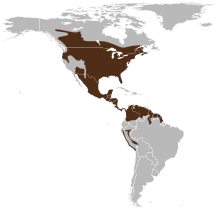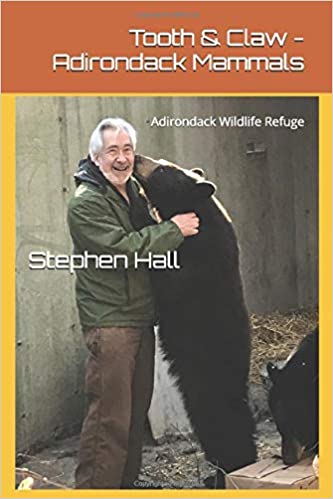|
White Tailed Deer Order: Artiodactyla Family: Cervidae Genus: Odocoileus Species: O. Virginianis Deer
appear in paleolithic cave paintings at Altamira,
on the north coast of Spain, going back 36,000 years. The white tailed
deer has
been in North America for about 4 million years, making the white tail
one of
the real veterans of nearly all varying habitats in North America,
ranging from
Nova Scotia west to southern Alberta, sweeping south into Central
America, with
gaps west of the Rockies. To put that in perspective, modern moose,
alces
alces, have only been in North America about 15,000 years, having
migrated
through Berengia about the same time the ancestors of native Americans
began to trickle across. In
North America, moose
have much more serious problems with winter
ticks in affected habitats than deer have. For example, deer go through
winter with an average of about 300 winter ticks, while moose may
accumulate from 10,000 to 90,000 winter ticks, a condition which has
moose in trouble all along the US-Canadian border from Maine to
Minnesota. Are white tails simply more efficient groomers, or could
there be
a connection related to longevity in habitat, and the ability of
animals to
adapt to parasites and challenges not found in previous habitats? Deer
have played a major role in human nutrition and
survival for a very long time. European immigrants to America, learned
from
native Americans about utilizing all parts of the white tail. Deer
numbers rose
and fell in the 19th century with market hunting by both
native
Americans and the growing numbers of settlers and immigrants, joining
individual hunting, along with deforestation and destruction of deer
habitat.
State regulation of hunting slowed down the hunting free-for-all, and
helped
increase deer numbers, but two other factors in the first decades of
the 20th
century led to an explosion of deer. Everything
in nature is connected. The increasing
suburbanization and the expansion of farming in America had the effect
of moving
more people into deer habitat, while introducing deer to our orchards,
crops
and gardens, thereby increasing their ability to making a living and
reproduce.
The more deer saw, heard and smelled human activity, without being shot
at,
the more it helped to inure them to the dangers of our presence. In
an environment without humans, gray wolves tend to
be the number one controller of both deer and western coyotes, the
latter in
competition for safer prey, smaller than moose, elk and bison, but the
accelerating persecution of gray wolves, which included poisoning
campaigns and
bounties led to an explosion of both deer and coyotes. Predators tend
to strengthen the health of prey populations by detecting and
eliminating disease and weakness. As
wolf habitat in the lower 48 dwindled to Minnesota,
the only state which kept the Federal wolfers out, western coyote
numbers
exploded out west, leading to a manifest destiny in reverse, with
coyotes
increasingly moving east under and over the Great Lakes,
exploiting available wolf habitat in the
lower 48, and causing further hybridization of Algonquin wolves in
Ontario and
Quebec, already averaging 20% western coyote going back tens of
thousands of
years, long before there were any humans in North America. Yes,
you read that correctly. Wolves have the most dangerous job in nature
for two reasons. An alpha female may deliver 4 to 7 pups every Spring.
While it is much safer for wolves to go after deer, snowshoe hare and
beaver, pressure to produce food compels wolves to go after much
larger, more dangerous prey, such as moose, elk and bison. Moose, for
example, are so dangerous in defending themselves, that wolves test 20
moose for each one they decide to take a chance and attack. As though
that factor in intself didn't make a wolf's life dangerous enough, in
wolf economics, the pack has to defend a territory large enough to
contain enough prey for the pack to make a living, and if a neighboring
pack's territory is not producing, they'll be invading another pack's
territory, which will result in wolves killing each other over access
to prey. Add these factors to our inclination to shoot wolves, and
wolves are lucky to reach their fifth birthday in the wild. Gray
wolves tend to kill coyotes, just as coyotes kill fox, routinely and
opportunistically eliminating the smaller predator, as a means of
creating a larger base of smaller, safer prey, but
starting in
Minnesota and heading east over Lake Superior, young male wolves, who
“disperse” from, in other words, leave Mom and Dad’s territory,
to seek an unguarded territory, or
a territory they may be able to take over, may discover that female
wolves
don’t generally disperse as far as males, so they may end up defending
a territory
no other wolf wants, and they may end up mating with a female coyote. Deer
hunters tend to bemoan the impact of eastern
coydogs, more accurately termed coywolves, because of their
hybridization with
Algonquin wolves, on the deer population in the Northeast. But the
coyote
impact on deer numbers is much greater on fawns than it is on adults,
partly
thanks to our assistance with traffic accidents supplying deer as
roadkill. A
study by SUNY College of Environmental Science
&
Forestry a few years back concluded that, excluding fawns, 92%
of deer
eaten by coyotes in New York were killed by cars. About 60% of fawns
reach
maturity, while
80% of fawn mortality is caused by predators, including bears, wolves,
coyotes,
cougars, bobcats, lynx, fishers, eagles, and even foxes. Other fawn
mortality
factors range from car accidents to getting caught in fencing or under
farm
equipment, or natural causes like starvation and drowning. More
recently, hunting generally, and deer hunting in
particular, which peaked among baby boomers in 1982, while rising in
some
states, and falling in others, is in a fairly steady decline
nationwide. We've
lost 10% of all hunters in the last ten years, with less than 4% of
Americans
involved in hunting today, at exactly a time when, having largely
eliminated
wolves, nature’s tool for deer control, we need more human hunters to
control
deer numbers. For those concerned about health and red meat, venison is
much
leaner than beef, and probably half the calories. Controlling deer without natural predators
is no easy problem. Highest deer densities are often found in
thickly settled suburban areas, where it is unsafe, and often
illegal, to fire rifles or shoot arrows, and the deer take a heavy toll
on gardens and landscaping generally. Some towns and villages are
experimenting with immunocontraception, to cut down the number of does
breeding. Such methods may require multiple doses, and may only be good
for a couple of years. Other towns employ specially vetted deer hunters
to control local deer populations. Habitat carrying capacities, which
increase as deer learn how to eat more human planted and invasive
vegetation, determine how many deer a particular area can support,
which means as you eliminate deer, other deer come in from surrounding
areas. In
New York State, we have just under a million deer, with
60 to 70 thousand in the Adirondacks, and about 70,000 vehicle deer
collisions statewide
annually. Hunters took about 225,000 deer in New York State in 2018. As
elegant
and visually appealing as white tails are, their lives tend to be
violent and
short, with the average age of death for deer being about 3 years old.
As a
sign of the times, the mosquito, which for 80 years was the most likely
animal to
be involved in human mortality in the lower 48 states, just as it is in
most
moderately temperate countries, was knocked out of first place by the
white
tailed deer, because of the number of people killed in accidents
involving
deer. Following
Bergman’s Rule, white
tails in colder climates will be larger on average than deer in warmer
climates, as
larger deer in colder climates are more likely to survive cold winters,
thus
surviving to breed and pass along their genes for superior size. While deer flourish in widely varying
habitat, ideal habitat tends to be woodlands, river valleys, forest
edge,
swamp, meadow and farmlands. The Adirondacks, with its rough
mountainous
terrain,
is not good habitat, and most of the hunters who hunt in the
Adirondacks are here
as much for the beauty and splendor of an Adirondack Autumn, and would
more
likely
find more deer in their back yards or local forest, than they will up
here. Adirondack
bucks average about 200 lbs, with mature females at about 160 lbs. Deer
are mainly browsers, feeding on leaves, shoots,
woody stems, shrubs, bushes or fruits. They also consume large
quantities of
forbs, mainly broad leaved, flowering plants, which are not grasses,
sedges or
rushes. Some grasses are grazed, along with some lichens and mosses.
But deer
are also opportunistic and will eat bird’s eggs, and even nestlings.
Food
proportions change season to season, based on availability, and while
there is
no season in which browse is not their main source of food, the highest
percentage
of browse is consumed in the winter, while the highest percentage of
forbs are
consumed in Spring and Summer. Special circumstances like nursing does,
rutting
bucks, etc. require higher quantities of food. Mature deer eat about
five to
seven pound of vegetation a day. Bucks
spend a great deal of nutrition growing those impressive antlers, which
begin to sprout in April, and are quite sensitive,
as they
are covered in a fuzzy skin called “velvet”, which contains nerves to
keep the
buck aware of physical obstacles in the immediate surrounding of the
growing
and vulnerable antlers, and blood vessels to feed oxygen to the
antlers, which consist
of cartilage, and two types of bone. The cells of interior “spongy”
bones
enable the inflow of nutrition and growth regulating hormones, and the
hardened
bones which make up the exterior of the antler, and whose gradual
thickening
will serve as the main weapons in the jousting and pushing of the rut. As
the antlers reach full size in August, the velvet
covering the hardened antlers dies and dries, and is sloughed off by
bushes,
tree branches and gravity. Like boxers in training camp, the bucks
begin to
spar with each other in preparation for the rut. As with bull moose,
large,
experienced bucks will spar playfully with youngsters preparing for
their first
rut. As they approach the November rut, buck necks thicken, preparing
for the
impact of serious fighting. The number and size of the tines on the
antlers not
only attract deer trophy hunters, but also signal the bucks readiness
for the
rut, and their desirability as mating partners to does. White
tail mating season in the Adirondacks peaks in
early November. Does go into estrus during this period, but are only
receptive
for about 24 hours at a time. What triggers estrus is not entirely
clear, but
most research cites a “photoperiod” meaning length of daylight, which
would
explain why estrus periods vary from climate to climate, with latitude
the most
important factor in providing the photoperiod. Does
leave hormonal clues, mainly melatonin, announcing
their condition as they move around, and aroused bucks follow these
scents,
often sparring with other bucks, for the right to mate with does, when
the does
are receptive, or to stay near the does, waiting for them to come into
heat. Bucks
become so focused on mating, that they will forgo eating. The rut
naturally
weakens them, and local predators like wolves and cougars will exploit
that vulnerability.
Does who
are not impregnated during the main rut, may enter a second estrus
period in
early December, which may lead to a second rut. Like moose, bucks will
drop
their antlers after the rut season is completely over, in the
Adirondacks
usually around New Years. Bucks
who have successfully mated with does, may hang around
the doe until her estrus cycle has ended, to discourage other bucks
from mating
with her. This type of behavior, protecting male semen, is found in a
wide
range of animals, even down to the insect world, where male damsel
flies
actually have a scoop appendage to “scrape” out the semen of other
males who
mate with their intended after they do. While I’m generally very skeptical about any explanation that smacks of teleology, the belief that nature has a purpose which manifests itself above and beyond the actions of individuals within a species, often used as a proof of a creator or intelligence which guides what happens in nature, this is indeed a fascinating observation. I’ve
always scoffed at the notion that the buck mounts
the receptive doe in order to insure the continuation of his genes,
rather than
just his compulsion to have sex because it is pleasurable, but here is
one
argument in favor, in as much as the intricacies of intercourse from
“foreplay”
to consummation do in fact lead to the continuance of your genes in the
gene
pool. And it doesn’t always work, as it is not uncommon for two sibling
fawns to
have different fathers. The
same thing happens in bear litters. Bear sows may mate
with a third boar, even as two other boars are battling to determine
mating
rights to their unfaithful sow. Someone should tell bucks and boars
that
fighting over the right to mate with their intended, may be less
productive
than just running around and mating with as many as you can! This
is the most productive time of year for the deer
hunters, but it is also unfortunately the most likely season for car
accidents,
as aroused bucks are even less careful near roads than they normally
would be, and
encounter unwary drivers who may be focused on the upcoming holiday
seasons. While
a doe can mate at only seven months old, most
bucks and does generally mate for the first time during their second
year. The doe’s
gestation period is about six and a half months Mature does commonly
give birth
to a litter of two fawns, while first year mothers usually have a
single fawn.
Mom will encourage a newborn fawn to stand and nurse within 20 minutes
of birth,
and will lead it to tall brush or grass, where it should be safe from
predators, while Mom forages to generate a milk supply for the fawn. Deer
fawns, as well as moose and elk calves, have less
odor than one would expect, because predators, over thousands of years
of
predation on them, inadvertently weed out the “stinkier” prey, leaving
the
surviving fawns and calves to survive and breed, passing along the
genes for
less odor. This makes the doe’s strategy of hiding her fawn in tall
grass and
brush a sensible solution, as they are not as likely to be smelled by
patrolling predators, unless they are stepped on by the predator. Folks
encounter fawns who are lying down, call us at the Wildlife Refuge to
report
there is something wrong with the fawn, because it makes no attempt to
escape.
We respond that the fawn is just doing its job, and you should clear
out, as
you may be noticed by mom, and the last thing we want is for her to
abandon her
fawn. Fawns
suckle mom for the first three months, will lose
their spots in the Fall, and will stay with Mom, usually through the
first
Winter, until they go out on their own the following Spring. Deer molt
their
coats twice a year, having tawnier, deeper tone coats in the Spring,
and
grayer, duller coats as camouflage for the Winter.
Steve Hall |
White tailed deer by Joe Kostoss, Eye in the Park
White tailed fawn and Doe, by Joe Kostoss, Eye in the Park
White tailed deer in Winter, by Joe Kostoss, Eye in the Park


| Home |
Release of
Rehabbed Animals |
Learn
About Adirondack & Ambassador Wildlife |
Critter
Cams & Favorite Videos |
History
of Cree & the Adirondack Wildlife Refuge |





